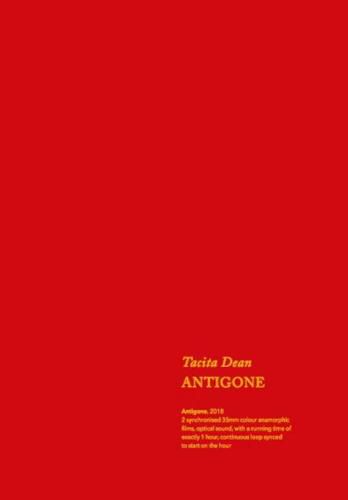Readings Newsletter
Become a Readings Member to make your shopping experience even easier.
Sign in or sign up for free!
You’re not far away from qualifying for FREE standard shipping within Australia
You’ve qualified for FREE standard shipping within Australia
The cart is loading…






Documenting Tacita Dean’s new film work on the many resonances of Sophocles’ drama
Tacita Dean’s (born 1965) Antigone (2018) is an hour-long 35mm anamorphic film, and is the most complex work to date by the British-European artist. The name of this work combines the artist’s personal history with the mythological world order: Antigone is the heroine in the eponymous drama by the Greek poet Sophocles, and is also the name of Tacita Dean’s older sister. The name creates a double bond full of ambivalences and is the reason for Dean’s exploration of the character.
The leitmotif of the work is blindness: Antigone revolves around fundamental questions of foresight and destiny, seeing and not seeing, and metaphorical blindness as a necessity for artistic work. It is also a thoroughly analogue work: Dean assembled the film images, which appear like collages, with and inside the camera using sophisticated stencils and multiple exposures. The result of this experimental project is both a pioneering achievement and a masterpiece. The book documents the narrative of the making and impact of this work.
$9.00 standard shipping within Australia
FREE standard shipping within Australia for orders over $100.00
Express & International shipping calculated at checkout
Documenting Tacita Dean’s new film work on the many resonances of Sophocles’ drama
Tacita Dean’s (born 1965) Antigone (2018) is an hour-long 35mm anamorphic film, and is the most complex work to date by the British-European artist. The name of this work combines the artist’s personal history with the mythological world order: Antigone is the heroine in the eponymous drama by the Greek poet Sophocles, and is also the name of Tacita Dean’s older sister. The name creates a double bond full of ambivalences and is the reason for Dean’s exploration of the character.
The leitmotif of the work is blindness: Antigone revolves around fundamental questions of foresight and destiny, seeing and not seeing, and metaphorical blindness as a necessity for artistic work. It is also a thoroughly analogue work: Dean assembled the film images, which appear like collages, with and inside the camera using sophisticated stencils and multiple exposures. The result of this experimental project is both a pioneering achievement and a masterpiece. The book documents the narrative of the making and impact of this work.